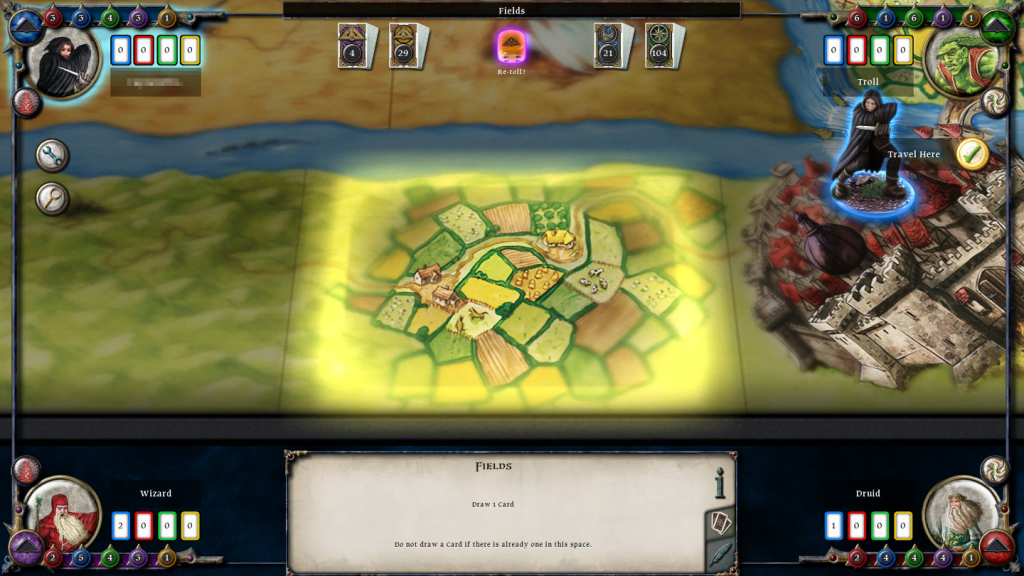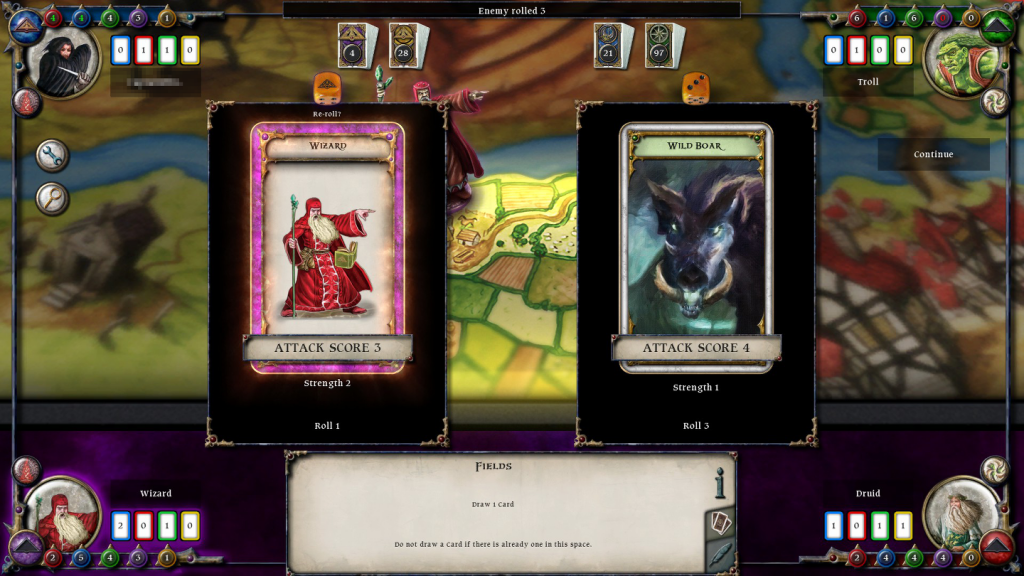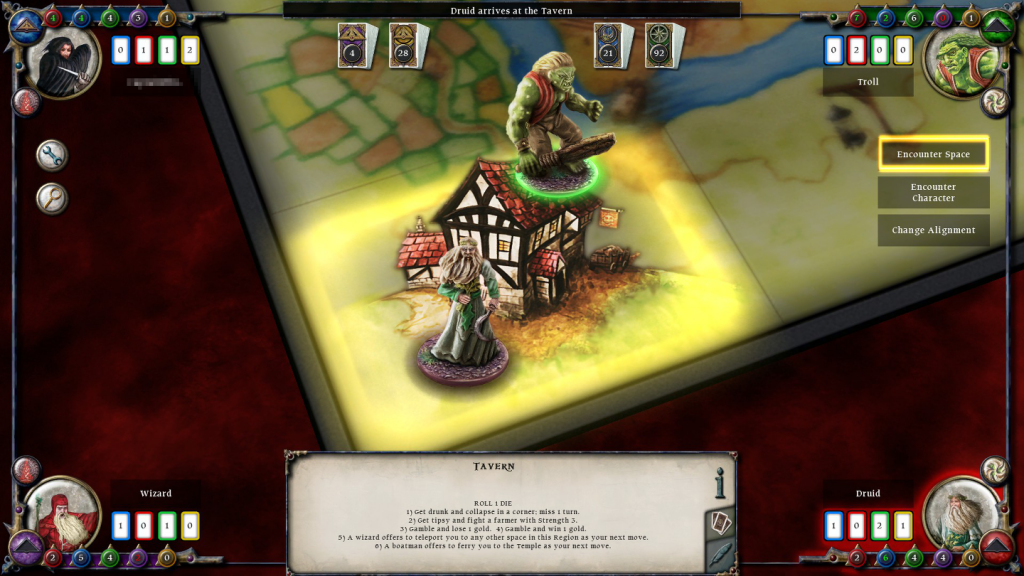Talisman is a fairly popular board game, or at the very least, well known. The goal of the game is to get to the center of the board and attain a crown that can be used to drive the other players out of the game, fighting off or at least trying to avoid the other players whilst doing so. Is this a faithful recreation of the Talisman board game? I won’t keep you hanging; yes, Talisman: Digital Edition is a completely faithful recreation, verified by myself and my brother, as he owns the board game and brought it out for us to inspect. I would soon find however that the game’s faithfulness to its physical version was both good and bad.
Let’s talk about the setting. Talisman is a medieval fantasy world where each player can choose to set out as a particular class with predetermined base stats. If you’ve ever played Hero Quest, selecting your character is very similar to that, except we have quite a few more options here. In the first game I played, I was an Assassin and was playing alongside three AI; a Wizard, Cleric, and Troll.
The world is divided into rings that shrink as they go into the center, each inner ring becoming more and more dangerous. We all started at staggering points in the outer ring and began our journey. At the start of your turn, you roll a single die to determine how many spaces you move. You then get to choose in which direction you want to move, clockwise or counter-clockwise around the ring. Almost every space you land on, unless otherwise specified, will have you drawing an Adventure Card that can be almost anything; an encounter with a monster, an item to pick up, or some kind of special event that must be dealt with. The interesting bit about Talisman is that Adventure Cards can often be left on that space on the board, leaving another player to deal with the encounter later. For instance, a Swamp card had come up which turns the current tile into a swamp. This means everyone who lands on that square must pass a Strength check, or else they miss their next turn.
Landing on a space with another player doesn’t always mean combat; it’s up to the moving player. If you do choose to engage in combat (with a player or a monster), you’ll have to roll an attack value greater than theirs (adding the value on the die with your base attack stat). Doing so against a player will remove 1 life from the loser; each class has a different life pool, and if it’s empty, that player is out of the game. Still, with so many ways to replenish life, it seems unlikely that you’ll win a game simply by bludgeoning the other players to death (though it’s clearly a possibility).
If you can’t win a fight against a monster, you can leave the space on your next turn, meaning whoever lands on that space next will have to fight the monster instead. That said, running away from monsters isn’t something you want to get into the habit of. When you kill a monster, you get their card as a trophy. If you turn in monster cards with a total Strength value of 7, you permanently gain 1 Strength for your character (and the same for Craft, which is mental attack ability). As an Assassin, and with dragons having exactly 7 Strength, I soon was able to instantly assassinate dragons and gain very fast stat upgrades… undoubtedly meant to be the Assassin’s specialty and purpose.
I however was the only Evil character on the board, and alignment matters for a great number of things. Although your alignment can change through many circumstances, for the most part you are stuck with the alignment of your class. Adventure Cards can have bonuses that apply to only Good or Evil players, with their detrimental effects being applied to characters of the opposite alignment. It would seem that being Neutral is the “safe” alignment; I saw no cards in the duration of playing that would have any effect on them, good or bad.
All of this is good stuff and makes for an interesting game that is fun, but it’s not all rosy. The game’s interface is very strange, and works against any sort of natural learning. Many elements on the interface have no tooltips, so if it’s your first time playing and you’ve forgotten what something is, the interface won’t be offering any help. I forgot what Fate points were for, and had to just wait until an event came up where I used Fate until I could, by context, re-learn what it was. Scrolling horizontally through cards is also extremely strange. The arrow buttons don’t work the first time you click them, and subsequently always work, but “click” on the pressing of your mouse button rather than the release. It’s a guarantee you’ll be thrown off and weirded out by it, so it might be helpful to know that you can click and drag a line of card choices to scroll through them much easier.
There seems to also be a strange (but harmless) bug where the game will sometimes simply zoom in on the wrong player’s figurine when it’s another person’s turn. This caused a bit of confusion, as one time it zoomed in on my Assassin figure, then it was the Cleric rolling his die and moving instead. I thought somehow the game was rolling for me, then realized it wasn’t even my turn, but had zoomed in on me anyways.
But there’s a very good reason why this game isn’t going to be getting any major awards; it’s very poorly balanced. For the first two hours of play, I was having fun. The game is extremely random, but I acknowledged that and moved on, thinking the game surely wouldn’t do anything broken at this point. Well, that was true until the Wizard played his Random spell. The Random spell is just one of many spells players can cast in Talisman, and it’s easily the most ridiculous. The caster chooses a target, and one of many effects can happen based on the roll… most of which are devastatingly bad. If the affected player rolls a 1, they become a toad. Every single item is dropped on your current tile, and all of your combat stats drop to 1. You can move only 1 space, and can’t pick anything up. This lasts for three turns. During this time, every single item you worked at getting will likely be stolen, and you’ll probably also be gang beaten into losing most of your lives as you can no longer defend yourself during combat. To say it makes you lose a ton of progress at virtually no cost to the caster is not an overstatement. But it gets worse.
Another possibility of the Random spell is that you’ll roll one of the next few numbers up. One effect makes you lose all of your Strength and go back down to your base amount based on your character sheet. Temporarily, right? No. Permanently. Yet another effect can do the exact same thing, except for your Craft attribute. After spending 2 hours doing almost nothing but training up my Strength to face the beasties of the inner circles, a Wizard was able to dash away hours of progress using a spell that is easily obtainable and easily recastable. I was at the bottom of the ladder by quite a fat margin, and probably would never be able to catch up again; not with the outer ring now laden with environmental hazards built up from all the play time accumulated.
Had the game’s creators given any thought to balance, a card like this could simply never exist. It’s the Blue Shell of the board game world, and ruins the entire game all by itself. That the game has a random nature is no excuse, as all board games have some sort of random nature; random games can still be balanced, and putting “I Win” cards into a game that is otherwise this well thought out and deep seems like a tragic waste. If you want to play Talisman, I’d recommend finding someone with a physical copy. Unlike in real life, Talisman: Digital Edition offers no way to remove cards from the deck, so you must play with any game-breaking spells that the creators have put into the game thoughtlessly.
In closing, I can offer credit for being faithful in every detail to the physical game, but I am left deflated and sad. This could have been a great opportunity for the creators to balance the game in its new malleable digital form, but it has been squandered to simply port over even the game’s blemishes. The Digital Edition even has a boxed retail version in addition to the Steam version. It’s a cool little throwback, but as mentioned, with no way to remove cards from the deck, it’s hard to recommend anything but the board game itself.










